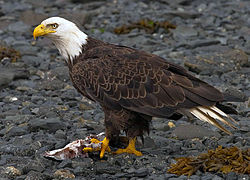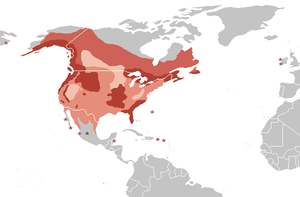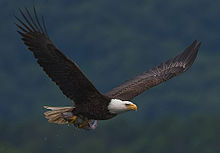From Wikipedia, the free encyclopedia
| Haliaeetus leucocephalus | |
|---|---|
 |
|
| Adult in Kodiak, Alaska, United States | |
| Conservation status | |
| Scientific classification |
|
| Kingdom: | Animalia |
| Phylum: | Chordata |
| Class: | Aves |
| Order: | Accipitriformes |
| Family: | Accipitridae |
| Genus: | Haliaeetus |
| Species: | H. leucocephalus |
| Binomial name | |
| Haliaeetus leucocephalus (Linnaeus, 1766) |
|
| Subspecies | |
|
H. l. leucocephalus – Southern Bald Eagle H. l. washingtoniensis – Northern Bald Eagle |
|
 |
|
| Bald Eagle range
Breeding resident
Breeding summer visitor
Winter visitor
On migration only
Star: accidental records |
|
| Synonyms | |
|
Falco leucocephalus Linnaeus, 1766 |
|
The Bald Eagle is an opportunistic feeder which subsists mainly on fish, which it swoops down and snatches from the water with its talons. It builds the largest nest of any North American bird and the largest tree nests ever recorded for any animal species, up to 4 m (13 ft) deep, 2.5 m (8.2 ft) wide, and 1 metric ton (1.1 short tons) in weight.[2] Sexual maturity is attained at the age of four to five years.
Bald Eagles are not actually bald; the name derives from an older meaning of "white headed". The adult is mainly brown with a white head and tail. The sexes are identical in plumage, but females are larger than males. The beak is large and hooked. The plumage of the immature is brown.
The Bald Eagle is both the national bird and national animal of the United States of America. The Bald Eagle appears on its Seal. In the late 20th century it was on the brink of extirpation in the continental United States. Populations recovered and the species was removed from the U.S. federal government's list of endangered species on July 12, 1995 and transferred to the list of threatened species. It was removed from the List of Endangered and Threatened Wildlife in the Lower 48 States on June 28, 2007.
Contents
Description
The plumage of an adult Bald Eagle is evenly dark brown with a white head and tail. The tail is moderately long and slightly wedge-shaped. Males and females are identical in plumage coloration, but sexual dimorphism is evident in the species in that females are 25% larger than males.[2] The beak, feet and irides are bright yellow. The legs are feather-free, and the toes are short and powerful with large talons. The highly developed talon of the hind toe is used to pierce the vital areas of prey while it is held immobile by the front toes.[3] The beak is large and hooked, with a yellow cere.[4] The adult Bald Eagle is unmistakable in its native range. The closely related African Fish Eagle (H. vocifer) (from far outside of the Bald Eagle's range) also has a brown body, white head and tail, but differs from the Bald in having a white chest and black tip to the bill.[5]The plumage of the immature is a dark brown overlaid with messy white streaking until the fifth (rarely fourth, very rarely third) year, when it reaches sexual maturity.[2][3] Immature Bald Eagles are distinguishable from the Golden Eagle (Aquila chrysaetos), the only other very large, non-vulturine bird in North America, in that the former has a larger, more protruding head with a larger beak, straighter edged wings which are held flat (not slightly raised) and with a stiffer wing beat and feathers which do not completely cover the legs. When seen well, the Golden Eagle is distinctive in plumage with a more solid warm brown color than an immature Bald Eagle, with a reddish-golden patch to its nape and (in immature birds) a highly contrasting set of white squares on the wing.[6] Another distinguishing feature of the immature Bald Eagle over the mature bird is its black, yellow-tipped beak; the mature eagle has a fully yellow beak.
The Bald Eagle has sometimes been considered the largest true raptor (accipitrid) in North America. The only larger species of raptor-like bird is the California Condor (Gymnogyps californianus), a New World vulture which today are not generally considered a taxonomic ally of true accipitrids.[7] However, the Golden Eagle, averaging 4.18 kg (9.2 lb) and 63 cm (25 in) in wing chord length in its American race (A. c. canadensis), is merely 455 g (1.003 lb) lighter in mean body mass and exceeds the Bald Eagle in mean wing chord length by around 3 cm (1.2 in).[5][8] Additionally, the Bald Eagle's close cousins, the relatively longer-winged but shorter-tailed White-tailed Eagle and the overall larger Steller's Sea Eagle (H. pelagicus), may, rarely, vagrate to coastal Alaska from Asia.[5]
 |
|
| Problems playing this file? See media help. | |
The call consists of weak staccato, chirping whistles, kleek kik ik ik ik, somewhat similar in cadance to a gull's call. The calls of young birds tend to be more harsh and shrill than those of adults.[5][6]
Taxonomy
The Bald Eagle placed in the genus Haliaeetus (sea eagles) which gets both its common and specific scientific names from the distinctive appearance of the adult's head. Bald in the English name is derived from the word piebald, and refers to the white head and tail feathers and their contrast with the darker body.[17] The scientific name is derived from Haliaeetus, New Latin for "sea eagle" (from the Ancient Greek haliaetos), and leucocephalus, Latinized Ancient Greek for "white head," from λευκος leukos ("white") and κεφαλη kephale ("head").[18][19]The Bald Eagle was one of the many species originally described by Linnaeus in his 18th century work Systema Naturae, under the name Falco leucocephalus.[20]
There are two recognized subspecies of Bald Eagle:[2][21]
- H. l. leucocephalus (Linnaeus, 1766) is the nominate subspecies. It is separated from H. l. washingtoniensis at approximately latitude 38° N, or roughly the latitude of San Francisco.[22] It is found in the southern United States and Baja California.[23]
- H. l. washingtoniensis (Audubon, 1827), synonym H. l. alascanus Townsend, 1897, the northern subspecies, is larger than southern nominate leucocephalus. It is found in the northern United States, Canada and Alaska.[2][23] This subspecies reaches further south than latitude 38° N on the Atlantic Coast, where they occur in the Cape Hatteras area.[22]
Range
The Bald Eagle's natural range covers most of North America, including most of Canada, all of the continental United States, and northern Mexico. It is the only sea eagle endemic to North America. Occupying varied habitats from the bayous of Louisiana to the Sonoran Desert and the eastern deciduous forests of Quebec and New England, northern birds are migratory, while southern birds are resident, remaining on their breeding territory all year. At minimum population, in the 1950s, it was largely restricted to Alaska, the Aleutian Islands, northern and eastern Canada, and Florida.[26] Today, they are much more common (almost attaining their peak numbers pre-colonization in North America), and nest in every continental state and province in the United States and Canada.[27]Bald Eagles will also congregate in certain locations in winter. From November until February, one to two thousand birds winter in Squamish, British Columbia, about halfway between Vancouver and Whistler. The birds primarily gather along the Squamish and Cheakamus Rivers, attracted by the salmon spawning in the area.[28]
It has occurred as a vagrant twice in Ireland; a juvenile was shot illegally in Fermanagh on January 11, 1973 (misidentified at first as a White-tailed Eagle), and an exhausted juvenile was captured in Kerry on November 15, 1987.[29]
Habitat
The Bald Eagle occurs during its breeding season in virtually any kind of American wetland habitat such as seacoasts, rivers, large lakes or marshes or other large bodies of open water with an abundance of fish. Studies have shown a preference for bodies of water with a circumference greater than 11 km (7 mi), and lakes with an area greater than 10 km2 (4 sq mi) are optimal for breeding Bald Eagles.[30]The Bald Eagle typically requires old-growth and mature stands of coniferous or hardwood trees for perching, roosting, and nesting. Tree species reportedly is less important to the eagle pair than the tree's height, composition and location.[31] Perhaps of paramount importance for this species is an abundance of comparatively large trees surrounding the body of water. Selected trees must have good visibility, be over 20 m (66 ft) tall, an open structure, and proximity to prey. If nesting trees are in standing water such as in a mangrove swamp, the nest can be located fairly low, at as low 6 m (20 ft) above the ground.[32] In a more typical tree standing on dry ground, nests may be located from 16 to 38 m (52 to 125 ft) in height. In Chesapeake Bay, nesting trees averaged 82 cm (32 in) in diameter and 28 m (92 ft) in total height, while in Florida, the average nesting tree stands 23 m (75 ft) high and is 23 cm (9.1 in) in diameter.[33][34] Trees used for nesting in the Greater Yellowstone area average 27 m (89 ft) high.[35] Trees or forest used for nesting should have a canopy cover of no more than 60%, and no less than 20%, and be in close proximity to water.[30] Most nests have been found within 200 m (660 ft) of open water. The greatest distance from open water recorded for a Bald Eagle nest was over 3 km (1.9 mi), in Florida.[7]
Bald eagle nests are often very large in order to compensate for size of the birds. The largest recorded nest was found in Florida in 1963, and was measured at nearly 10 feet wide and 20 feet deep.[36]
In Florida, nesting habitats often consist of mangrove swamps, the shorelines of lakes and rivers, pinelands, seasonally flooded flatwoods, hardwood swamps, and open prairies and pastureland with scattered tall trees. Favored nesting trees in Florida are Slash Pines (Pinus elliottii), Longleaf Pines (P. palustris), Loblolly Pines (P. taeda) and cypress trees, but for the southern coastal areas where mangroves are usually used.[32] In Wyoming, groves of mature cottonwoods or tall pines found along streams and rivers are typical bald eagle nesting habitats. Wyoming eagles may inhabit habitat types ranging from large, old-growth stands of Ponderosa Pines (Pinus ponderosa) to narrow strips of riparian trees surrounded by rangeland.[7] In Southeast Alaska, Sitka Spruce (Picea sitchensis) provided 78% of the nesting trees used by eagles, followed by hemlocks (Tsuga) at 20%.[31] Increasingly, eagles nest in man-made reservoirs stocked with fish.[32]

With freshly caught fish in Kodiak
While wintering, Bald Eagles tend to be less habitat and disturbance sensitive. They will commonly congregate at spots with plentiful perches and waters with plentiful prey and (in Northern climes) partially unfrozen waters. Alternately, non-breeding or wintering Bald Eagles, particularly in areas with a lack of human disturbance, spend their time in various upland, terrestrial habitats sometimes quite far away from waterways. In the Northern half of North America (especially the interior portion), this terrestrial inhabitance by Bald Eagles tends to be especially prevalent because unfrozen water may not be accessible. Upland wintering habitats often consist of open habitats with concentrations of medium-sized mammals, such as prairies, meadows or tundra, or open forests with regular carrion access.[7][31]
Behavior
The Bald Eagle is a powerful flier, and soars on thermal convection currents. It reaches speeds of 56–70 km/h (35–43 mph) when gliding and flapping, and about 48 km/h (30 mph) while carrying fish.[40] Its dive speed is between 120–160 km/h (75–99 mph), though it seldom dives vertically.[41] It is partially migratory, depending on location. If its territory has access to open water, it remains there year-round, but if the body of water freezes during the winter, making it impossible to obtain food, it migrates to the south or to the coast. A number of populations are subject to post-breeding dispersal, mainly in juveniles; Florida eagles, for example, will disperse northwards in the summer.[42] The Bald Eagle selects migration routes which take advantage of thermals, updrafts, and food resources. During migration, it may ascend in a thermal and then glide down, or may ascend in updrafts created by the wind against a cliff or other terrain. Migration generally takes place during the daytime, usually between the local hours of 8:00 a.m. and 6:00 p.m., when thermals are produced by the sun.[3]Diet and feeding
The Bald Eagle is an opportunistic carnivore with the capacity to predate a great variety of prey. Throughout their range, fish often compromise the majority of the eagle's diet.[43] In 20 food habit studies across the species' range, fish comprised 56% of the diet of nesting eagles, birds 28%, mammals 14% and other prey 2%.[44] In Southeast Alaska, fish comprise approximately 66% of the year-around diet of Bald Eagles and 78% of the prey brought to the nest by the parents.[45] Eagles living in the Columbia River Estuary in Oregon were found to rely on fish for 90% of their dietary intake.[46] In the Pacific Northwest, spawning trout and salmon provide most of the Bald Eagles' diet from late summer throughout fall.[47] Southeast Alaskan eagles largely predate Pink salmon (Oncorhynchus gorbuscha), Coho salmon (O. kisutch) and, more locally, Sockeye salmon (O. nerka), with Chinook salmon (O. tshawytscha), due to their large size (12 to 18 kg (26 to 40 lb) average adult size) probably being taken only as carrion.[45] Also important in the estuaries and shallow coastlines of southern Alaska are Pacific herring (Clupea pallasii), Pacific sand lance (Ammodytes hexapterus) and Eulachon (Thaleichthys pacificus).[45] In Oregon's Columbia River Estuary, the most significant prey species were Largescale suckers (Catostomus macrocheilus) (17.3% of the prey selected there), American shad (Alosa sapidissima; 13%) and Common Carp (Cyprinus carpio; 10.8%).[46] Eagles living in the Chesapeake Bay in Maryland were found to subsist largely on American gizzard shad (Dorosoma cepedianum), Threadfin shad (D. petenense) and White bass (Morone chrysops).[48] Floridian eagles have been reported to predate catfish, mostly prevalently the Brown bullhead (Ameiurus nebulosus) and any species in the Ictalurus genus as well as mullet, trout, needlefish, and eels.[7][32][49] Wintering eagles on the Platte River in Nebraska preyed mainly on American gizzard shads and Common Carp.[50] From observation in the Columbia River, 58% of the fish were caught directly by the predating eagle, 24% were scavenged as carcasses and 18% were pirated away from other animals.[46]Even eagles living in relatively arid regions still typically rely primarily on fish as prey. In Sonora, Mexico and Arizona, 77% and over 73%, respectively, of prey remains at the nests were from fish, largely various catfish and Rainbow trout (Oncorhynchus mykiss). Prey fish targeted by Bald Eagles are often quite large. When experimenters offered fish of different sizes in the breeding season around Lake Britton in California, fish measuring 34 to 38 cm (13 to 15 in) were taken 71.8% of the time by parent eagles while fish measuring 23 to 27.5 cm (9.1 to 10.8 in) were chosen only 25% of the time.[51] At nests around Lake Superior, the remains of fish (mostly suckers) were found to average 35.4 cm (13.9 in) in total length.[52] In the Columbia River estuary, most predated by eagles were estimated to measure between 30 and 60 cm (12 and 24 in) in length, and carp flown with (laboriously) were up to 86 cm (34 in) in length.[46]
Benthic fishes such as catfish are usually consumed after they die and float to the surface, though while temporarily swimming in the open may be more vulnerable to predation than most fish since their eyes focus downwards.[48] Bald Eagles also regularly exploit water turbines which produce battered, stunned or dead fish easily consumed.[53] Predators who leave behind scraps of dead fish that they kill, such as Brown Bears (Ursus arctos), Gray Wolves (Canis lupus) and Red Foxes (Vulpes vulpes), may be habitually followed in order to scavenge the kills secondarily.[45] Once North Pacific salmon die off after spawning, usually local Bald Eagles eat salmon carcasses almost exclusively. Eagles in Washington need to consume 489 g (1.078 lb) of fish each day for survival, with adults generally consuming more than juveniles and thus reducing potential energy deficiency and increasing survival during winter.[44]
Behind fish, the next most significant prey base for Bald Eagles are other waterbirds. The contribution of such birds to the eagle's diet is variable, depending on the quantity and availability of fish near the water's surface. Waterbirds can seasonally comprise from 7% to 80% of the prey selection for eagles in certain localities.[46][54] Exceptionally, in the Greater Yellowstone area, birds were eaten as regularly as fish year-around, with both prey groups comprising 43% of the studied dietary intake.[35] Preferred avian prey includes grebes, alcids, ducks, gulls, coots, herons, egrets, and geese.[55] Bird species most preferred as prey by eagles tend to be medium-sized, such as Western Grebes (Aechmophorus occidentalis), Mallards (Anas platyrhynchos) and American coots (Fulica americana) as such prey is relatively easy for the much larger eagles to catch and fly with.[7][46] American Herring Gull (Larus smithsonianus) are the favored avian prey species for eagles living around Lake Superior.[52] Larger waterbirds are occasionally predated as well, with wintering Emperor Geese (Chen canagica) and Snow Geese (C. caerulescens), which gather in large groups, sometimes becoming regular prey.[15][56] Other large waterbirds hunted at least occasionally by Bald Eagles have included Common Loons (Gavis immer),[57] Great Black-backed Gulls (Larus marinus),[58] Sandhill Cranes (Grus canadensis),[59] Great Blue Herons (Ardea herodias),[44] Canada Geese (Branta canadensis),[48] Brown Pelicans (Pelecanus occidentalis),[32] and fledging American White Pelicans (P. erythrorhynchos).[60] Colony nesting seabirds, such as alcids, storm petrels, cormorants, Northern Gannets (Morus bassanus), terns and gulls, may be especially vulnerable to predation. Due to easy accessibility and lack of formidable nest defense by such species, Bald Eagles are capable of predating such seabirds at all ages, from eggs to mature adults, and can effectively cull large portions of a colony.[61]




No comments:
Post a Comment